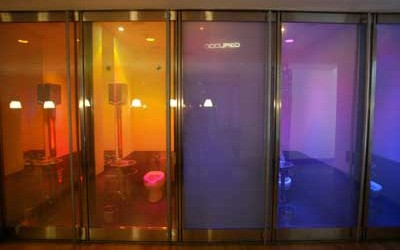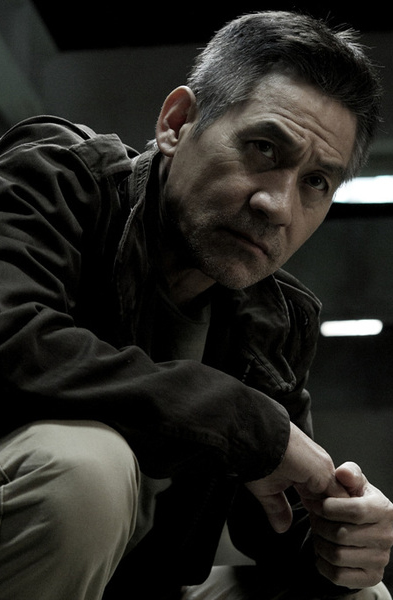

The year 2028 saw the beginning, and 2031 witnessed the end. “It” started small, of course, and truth be told, no one could ever say for sure when “it” had started, or how. But eventually “The Change” had crept up over the coasts of Chile from the Pacific.
"The Change."
Sure, the press-assigned name was innocuous, rather dull to say the least, but that did not make the initial swath of destruction any less horrific. Fish and sea mammals died off in numbers that left South American coast lands a wasteland of rotting carcasses. And every so often, a thick, poisonous yellow mist would blow inland, choking every living thing unfortunate enough to cross its path.
The eco-zealots worked themselves into a frenzy, screaming their half-assed theories from every makeshift pulpit they could find about secret giant corporate chemical dumps, or biological weapons, or the “natural consequences of anthropogenic global warming,” and so on, ad nauseum.
That is, until the first of the New Kind made their way to shore.
These… things, these creatures of the New Kind – had no precedent anywhere in the hundreds of millions of years of Earth’s evolutionary path, emerging from the oceans and infected shores in just a few stupefying months. Evolutionary and marine and terrestrial biologists, oceanographers and virologists and climatologists alike were helpless to provide any inkling of an explanation for their appearance, much less a solution .
A matter of no consequence to the New Kind. The aquatic creatures came first insect-like creatures came first – at least to the visible eye - and then the reptilian, the avian and eventually some that almost resembled mammalian life forms. There were only two common factors between all The mist didn’t kill them. Rather, the Kind seemed to thrive in the thick poison that killed all other life.
The enviro-cultists remained convinced the Kind were mutations produced by pollutants or contaminants of some type. What other explanation could there possibly be? How else to explain what had happened to the once happy-go-lucky ocean creatures, obviously deformed into hideous monstrosities by the greed of giant corporate interests and the callous disregard of all those vicious SUV drivers with their murderous carbon footprints?
Evolutionary scientists hypothesized this might be the start of a mass extinction event; that perhaps the disappearance of the dinosaurs had nothing to do with a cataclysmic meteor strike, but some hitherto unknown mechanism that initiated a radical change in the entire biosphere.
But the proverbial life’s breath was summarily sucked out of the world for all time with the final, truly terrifying revelation: hex-stranded DNA.
Alien. Whatever the hell was happening, it was not – and never had been – terrestrial in origin.
The aliens had landed – and somehow, no one had even noticed. Space and surveillance agencies across the globe, from NASA to the Russian Federal Space Agency, were all “baffled” according to their copious press releases – not that it mattered for long. As if someone – or something - had flicked a switch, The Change began to spread with a sickening speed, expanding its reach geometrically, grasping fingers of irrevocable death across every oceans and continent.
Initial efforts to “quarantine” the affected areas of South America in the heat of nuclear fires were doomed from the start. Whatever the hell these things were, they brought their environment with them - atmosphere and strange plant life, single-celled and multi-celled organisms all consuming and digesting and regurgitating the rich primordial soup of Earth’s living biology to promulgate its own existence. The paper thin layer of organic life that had always lived on Earth was simply being devoured. Eaten and shat out for something no longer even… Recognizable…

The last known enclave for Earth’s pre-Change biology was known as “The Mountain.” A top secret joint military and civilian base located in the Rockies of southwest Wyoming, this unprecedented undertaking dwarfed even the Cheyenne Mountain Complex in size and scope, The Mountain did not even have a proper name beyond the rather obvious moniker. And yet near a century of unprecedented, unwavering dedication and international cooperation was the lifeblood of this complex. Nation of origin - Israeli or Chinese, American or Sudanese or Russian or Norwegian or any hundreds others over the decades – were all subsumed to their single-minded dedication to their respective work and fields of study. Financed entirely by vast sums of private capital, organized beneath the protective auspices of the U.S. military, the work the scientists, researchers and engineers developed in The Mountain was entirely cutting edge, highly experimental - pure science for its own sake, unfettered by financial or governmental restraints. Suspended animation, biostasis, asteroid mining, faster-than-light travel, reactionless drives – science fiction was being made real, all with the lofty hope of seeing humanity colonized among the stars.
But with The Change came a new sense of urgency among these brilliant men and women, the first inklings that something was about to go horribly, irrevocably wrong with the whole damned world. The unthinkable somehow became the probable, and then a horrific certainty. Their ambassadorial flagship the Copernicus, mankind’s greatest technological achievement to date, would become humanity’s ark.
Or rather, an interstellar Noah’s ark.
Even as cities, nations, and then entire continents were snuffed out of existence, devoured by the relentless, fatal colonization of the New Kind, those still working in and around the Copernicus fought to the bitter end to recover every last human life left possible in the contaminated environs, though these gains were precious few. Agricultural, space farming and microgravity experimentation – and one desperate run to a nearby wildlife rescue sanctuary – ensured everything from paramecia and wolves, blue algae and red roses, found their place among the denizens of the Copernicus. Only when they were certain there was nothing more salvageable in the poisonous wasteland that had once been Earth, the side of that nameless mountain was blown out and the Copernicus launched to begin its fifteen year sojourn.
Fifteen years. Annual shifts were established for a handful of the six thousand, seven hundred and twenty-two adults aboard, rotated out so that walking, talking people could watch the hydroponic projects, care for the animals they were able to salvage, perform maintenance and resource recovery on the Copernicus, chart the medical progress of the “sleepers,” and pilot the ship.
Fifteen years, until they came to the first planet that might - just might - sustain human life.

Despite the invaluable treasure she ferries across the galaxy, the Copernicus is not herself a lovely ship. Some 400 meters in length, the ship’s exterior is smoothly cylindrical when fully operational, and segmented into five identical, rotating sections that turn about an axis comprised of the ship’s separate engine bays. Within the engine axis is a series of passable holds and locks that can be detached in case of emergency or, as they were originally designed, at planet fall on the less-than-sexily-named M15233-18.
Otherwise known – either tongue-in-cheek or with a desperate hopeful fervor by the crew of the Copernicus – as Canaan, “the Promised Land.”
The sweet Promise Land of Canaan, anticipating the arrival of her new people on the Copernicus.
Each of her five sections is a completely self-sustaining unit, containing both human, animal and plant samples salvaged from Earth. All shipboard assets - from hydroponic laboratories to engineering bays and medical facilities, from the waking crew living quarters and mess to animal pens and reclamation processors - are all spaced equilaterally within each. In addition, four pod-bays are located at a “pole” within every segment, each pod-bay capable of supporting five hundred “sleepers.” At the moment, those still held in stasis are spread more-or-less evenly throughout the Copernicus, though of course all family members – sleepers or the handful of wakened crew – are housed within the same section.
This is the Earth year 2034 AD, and the start of the third “shift change” aboard the Copernicus. The oncoming crew is being woken from stasis, receiving their respective status briefings and preparing to begin their annual duties – this time, to include the essential harvest of ice from asteroids located at their aphelion orbit of the red dwarf G217. The first of four scheduled materiel collections operations in “normal space,” this will be a true test of nerve, skill and design for the awakening crew.

The Copernicus is approximately 400 meters in length, the exterior built with utility in mind. The entire ship resembles nothing so much as an enormous cylinder comprised of five equilateral sections surrounding an axis through its center. Each of these sections, specifically designed to separate at planet fall, is self-sustaining, outfitted identically in terms of personnel and supplies, and capable of independent space and terrestrial travel. For so long as the Copernicus' sections remain intact however, the command module of the forward (first) section remains the main location for the vast majority of piloting and navigation.



Because many of the awake crew will have to perform multiple shifts, every wakened crew member has his or her own personal room, to be decorated - or not - as desired. These rooms consist of a bed, multiple built-in storage areas, a "portal" portraying any view desired and communications access and, while not spacious, do provide a modicum of privacy and "normalcy" in the most extraordinary of circumstances.



Recreational and mess areas were deliberately constructed to provide for comfort and ease, and are deliberately neither military Spartan nor austere. Though bathrooms are by necessity communal, considerations for privacy, dignity and a very human touch were intentionally designed in their layout.

The vast majority of those on the Copernicus are, of course, in cryostasis. Within each of the five sections are located four different stasis bays, each bay capable of maintaining 500 beds at a time. It is the vital work of the medical technicians to ensure all these beds are maintained and monitored each day of the Copernicus' sojourn.

The asteroid mining ships and the crews that operate them ensure the lifeblood of the Copernicus continues to flow.

Specially designed space exosuits have been developed to cater to the specific job-related needs of each crew member who must enter the vacuum of space, to include maintenance personnel, engineers and the asteroid mining crews.

AmongHeroes: Dr. Gavin Brock
Derren Krenshaw: Antoine Eadoré
Dotcom: Deli Beltran
idlehands: Owen Reece
Igraine: 1SG Abigail Larson
Justric: Robert S. Bach
KuroTenshi: Connor Douglass
Lillian Thorne: Stella Albright, DVM
RoadRash: William "Big Bill" Cothran
Derren Krenshaw: Mowzer
Dotcom: Maya E. Coleman, Ha-neul Bae Park
idlehands: Ester Baum, Naomi Ben Zeev, Henry Graham
Igraine: MG Benjamin S. Lahan, Pauline Bethany Weber
Justric: Jack Pumphrey
Lillian Thorne: Penelope Raffin
RoadRash: Sgt Michael Davis
 And after this post here, I'll post a CS for my character that can serve as a template for anyone who might still need one. Long or short, it really doesn't matter at all - just something to introduce your character to the rest of us!
And after this post here, I'll post a CS for my character that can serve as a template for anyone who might still need one. Long or short, it really doesn't matter at all - just something to introduce your character to the rest of us!










